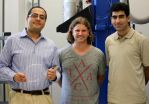(Press-News.org) Balance and strength training is known to reduce falls in older adults. However, less than 10% of older people routinely engage in strength training and it is likely that this is much lower for activities that challenge balance.
It has been suggested that integrating exercise into everyday activities may help people stick to it, but this approach has never been investigated in frail older people at risk of falls.
So a team of researchers at the University of Sydney designed and tested the Lifestyle integrated Functional Exercise (LiFE) programme, which involves embedding balance and lower limb strength training into daily routines, such as walking, stepping over objects and moving from sitting to standing.
They then compared this approach with a structured exercise programme (performed three times a week using ankle cuff weights) and gentle 'sham' exercises that acted as the study control.
They recruited 317 men and women aged 70 or older, living in the community and having two or more falls, or one injurious fall, in the past year.
Participants were split into the three treatment arms and recorded any falls over 12 months using daily calendars. Other measures like static and dynamic balance, ankle, knee and hip strength, daily living activities, and quality of life were also measured recognised scales.
They found a significant (31%) reduction in the rate of falls for participants in the LiFE programme compared with the control group. The overall incidence of falls in the LiFE programme was 1.66 per person years, compared with 1.90 in the structured programme and 2.28 in the control group.
There was a non-significant reduction in the rate of falls for participants in the structured programme compared to the control group.
Compared with control patients, LiFE participants showed improvements in both static and dynamic balance, ankle strength, and in function and participation in daily life, suggesting that this programme improves both fall risk and frailty.
Adherence was significantly better in the LiFE programme and control group compared with the structured exercise programme.
The authors conclude that the LiFE programme "provides an alternative to traditional exercise for older people to reduce falls, to improve function in doing activities and to enhance participation in daily life."
In an accompanying editorial, Professor Meg Morris from the University of Melbourne says that for fall prevention programmes in older people to be effective, "therapeutic exercises, education, and physical activities need to be sustainable, enjoyable, and effective over the long term."
She adds: "The belief that falls should be accepted and tolerated as part of the ageing process is a myth that needs dispelling. Many falls can and should be prevented."
### END
Balance and strength training can prevent falls in older people
Embedding exercises into daily routines can cut falls by almost a third
2012-08-08
ELSE PRESS RELEASES FROM THIS DATE:
Study finds a new pathway for invasive species – science teachers
2012-08-08
CORVALLIS, Ore. – A survey of teachers from the United States and Canada found that one out of four educators who used live animals as part of their science curriculum released the organisms into the wild after they were done using them in the classroom.
Yet only 10 percent of those teachers participated in a planned release program, increasing the likelihood that the well-intentioned practice of using live organisms as a teaching tool may be contributing to invasive species problems.
The study was presented today (Aug. 7) in Portland at the national meeting of the ...
Plain packaging of cigarettes encourages young smokers to heed health warnings
2012-08-08
New research published online in the scientific journal Addiction shows that plain packaging (requiring cigarettes to be packaged in standard packages without attractive designs and imagery) may help to draw the attention of some adolescent smokers to the health warnings on the package. If so, this may in turn deter young smokers from continuing to smoke.
Researchers asked eighty-seven teenage secondary school (high school) students from the city of Bristol, UK, to look at twenty images of cigarette packs on a computer screen for ten seconds each while a device tracked ...
Thinner diabetics face higher death rate
2012-08-08
CHICAGO --- American adults of a normal weight with new-onset diabetes die at a higher rate than overweight/obese adults with the same disease, according to a new Northwestern Medicine study.
The study, to be published in the Aug. 7 issue of JAMA, found that normal-weight participants experienced both significantly higher total and non-cardiovascular mortality than overweight/obese participants.
Normal-weight adults with type 2 diabetes have been understudied because those who typically develop the disease are overweight or obese. In this study about 10 percent of those ...
Coach could be key in helping stroke patients
2012-08-08
WINSTON-SALEM, N.C. – August 6, 2012 – When a stroke patient is discharged from the hospital, they often must cope with a new disability or lack of function, so changes in their medications or a new dosing prescription can be particularly confusing. This can lead the patient to overmedicate, take the wrong medication or skip medications entirely and can result in being readmitted to the hospital.
But a pilot study that is looking at a new discharge strategy and being led by researchers at Wake Forest Baptist Medical Center, indicates that phone calls and conversations ...
Using millions of years of cell evolution in the fight against cancer
2012-08-08
As the medical community continues to make positive strides in personalized cancer therapy, scientists know some dead ends are unavoidable. Drugs that target specific genes in cancerous cells are effective, but not all proteins are targetable. In fact, it has been estimated that as few as 10 to 15 percent of human proteins are potentially targetable by drugs. For this reason, Georgia Tech researchers are focusing on ways to fight cancer by attacking defective genes before they are able to make proteins.
Professor John McDonald is studying micro RNAs (miRNAs), a class ...
UCF nanoparticle discovery opens door for pharmaceuticals
2012-08-08
What a University of Central Florida student thought was a failed experiment has led to a serendipitous discovery hailed by some scientists as a potential game changer for the mass production of nanoparticles.
Soroush Shabahang, a graduate student in CREOL (The College of Optics & Photonics), made the finding that could ultimately change the way pharmaceuticals are produced and delivered.
The discovery was based on using heat to break up long, thin fibers into tiny, proportionally sized seeds, which have the capability to hold multiple types of materials locked in ...
New drug successfully halts fibrosis in animal model of liver disease
2012-08-08
A study published in the online journal Hepatology reports a potential new NADPH oxidase (NOX) inhibitor therapy for liver fibrosis, a scarring process associated with chronic liver disease that can lead to loss of liver function.
"While numerous studies have now demonstrated that advanced liver fibrosis in patients and in experimental rodent models is reversible, there is currently no effective therapy for patients," said principal investigator David A. Brenner, MD, vice chancellor for Health Sciences and dean of the School of Medicine at the University of California, ...
Chemists advance clear conductive thin films
2012-08-08
PROVIDENCE, R.I. [Brown University] — In a touch-screen display or a solar panel, any conductive overlay had better be clear. Engineers employ transparent thin films of indium tin oxide (ITO) for the job, but a high-tech material's properties are only half its resume. They must also be as cheap and easy to manufacture as possible. In a new study, researchers from Brown University and ATMI Inc. report the best-ever transparency and conductivity performance for an ITO made using a chemical solution, which is potentially the facile, low-cost method manufacturers want.
"Our ...
Diseased trees new source of climate gas
2012-08-08
Diseased trees in forests may be a significant new source of methane that causes climate change, according to researchers at the Yale School of Forestry & Environmental Studies in Geophysical Research Letters.
Sixty trees sampled at Yale Myers Forest in northeastern Connecticut contained concentrations of methane that were as high as 80,000 times ambient levels. Normal air concentrations are less than 2 parts per million, but the Yale researchers found average levels of 15,000 parts per million inside trees.
"These are flammable concentrations," said Kristofer Covey, ...
Researchers demonstrate control of devastating cassava virus in Africa
2012-08-08
ST. LOUIS, MO, August 7, 2012— An international research collaboration recently demonstrated progress in protecting cassava against cassava brown streak disease (CBSD), a serious virus disease, in a confined field trial in Uganda using an RNA interference technology. The field trial was planted in November 2010 following approval by the National Biosafety Committee of Uganda. The plants were harvested in November 2011 and results were published in the August 1, 2012 issue of the journal Molecular Plant Pathology . These results point researchers in the right direction ...
LAST 30 PRESS RELEASES:
Transforming acoustic waves with a chip
When climate risk hits home, people listen: Study reveals key to engagement with disaster preparedness messaging
Major breakthrough against diabetes thanks to a microbial molecule that disarms inflammation
Silicon chips on the brain: Researchers announce a new generation of brain-computer interface
Getting rest is the best
Towards sustainable organic synthesis – Mechanochemistry replaces lithium with sodium in organic reactions
Wireless device ‘speaks’ to the brain with light
Greenhouse gases to intensify extreme flooding in the Central Himalayas
New study sheds light on Milky Way's mysterious chemical history
Could altering the daily timing of immunotherapy improve survival in people with cancer?
Weaving secondary battery electrodes with fibers and tying them like ropes for both durability and performance
Using social media may impair children’s attention
Science briefing: An update on GLP-1 drugs for obesity
Lower doses of immunotherapy for skin cancer give better results
Why didn’t the senior citizen cross the road? Slower crossings may help people with reduced mobility
ASH 2025: Study suggests that a virtual program focusing on diet and exercise can help reduce side effects of lymphoma treatment
A sound defense: Noisy pupae puff away potential predators
Azacitidine–venetoclax combination outperforms standard care in acute myeloid leukemia patients eligible for intensive chemotherapy
Adding epcoritamab to standard second-line therapy improves follicular lymphoma outcomes
New findings support a chemo-free approach for treating Ph+ ALL
Non-covalent btki pirtobrutinib shows promise as frontline therapy for CLL/SLL
University of Cincinnati experts present research at annual hematology event
ASH 2025: Antibody therapy eradicates traces of multiple myeloma in preliminary trial
ASH 2025: AI uncovers how DNA architecture failures trigger blood cancer
ASH 2025: New study shows that patients can safely receive stem cell transplants from mismatched, unrelated donors
Protective regimen allows successful stem cell transplant even without close genetic match between donor and recipient
Continuous and fixed-duration treatments result in similar outcomes for CLL
Measurable residual disease shows strong potential as an early indicator of survival in patients with acute myeloid leukemia
Chemotherapy and radiation are comparable as pre-transplant conditioning for patients with b-acute lymphoblastic leukemia who have no measurable residual disease
Roughly one-third of families with children being treated for leukemia struggle to pay living expenses
[Press-News.org] Balance and strength training can prevent falls in older peopleEmbedding exercises into daily routines can cut falls by almost a third


